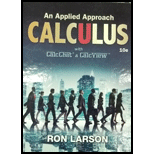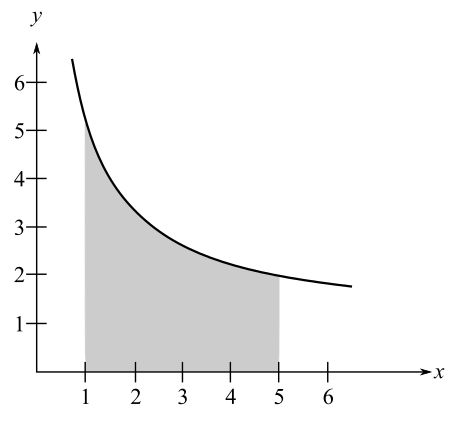
Calculus: An Applied Approach (MindTap Course List)
10th Edition
ISBN: 9781305860919
Author: Ron Larson
Publisher: Cengage Learning
expand_more
expand_more
format_list_bulleted
Question
Chapter B, Problem 32E
To determine
To fill: The blank with the symbol <, > or = in the statement n∑i=1f(xi)Δx_____5∫1f(x)dx using the figure, where xi is the right endpoint of the ith subinterval.

And, also explain the reasoning.
Expert Solution & Answer
Want to see the full answer?
Check out a sample textbook solution
Students have asked these similar questions
1. Abel's Theorem. The goal in this problem is to prove Abel's theorem by following a series of steps
(each step must be justified).
Theorem 0.1 (Abel's Theorem).
If y1 and y2 are solutions of the differential equation
y" + p(t) y′ + q(t) y = 0,
where p and q are continuous on an open interval, then the Wronskian is given by
W (¥1, v2)(t) = c exp(− [p(t) dt),
where C is a constant that does not depend on t. Moreover, either W (y1, y2)(t) = 0 for every t in I or
W (y1, y2)(t) = 0 for every t in I.
1. (a) From the two equations (which follow from the hypotheses),
show that
y" + p(t) y₁ + q(t) y₁ = 0 and y½ + p(t) y2 + q(t) y2 = 0,
2. (b) Observe that
Hence, conclude that
(YY2 - Y1 y2) + P(t) (y₁ Y2 - Y1 Y2) = 0.
W'(y1, y2)(t) = yY2 - Y1 y2-
W' + p(t) W = 0.
3. (c) Use the result from the previous step to complete the proof of the theorem.
2. Observations on the Wronskian. Suppose the functions y₁ and y2 are solutions to the differential
equation
p(x)y" + q(x)y' + r(x) y = 0
on an open interval I.
1. (a) Prove that if y₁ and y2 both vanish at the same point in I, then y₁ and y2 cannot form a
fundamental set of solutions.
2. (b) Prove that if y₁ and y2 both attain a maximum or minimum at the same point in I, then y₁ and
Y2 cannot form a fundamental set of solutions.
3. (c) show that the functions & and t² are linearly independent on the interval (−1, 1). Verify that
both are solutions to the differential equation
t² y″ – 2ty' + 2y = 0.
Then justify why this does not contradict Abel's theorem.
4. (d) What can you conclude about the possibility that t and t² are solutions to the differential
equation
y" + q(x) y′ + r(x)y = 0?
Question 4 Find an equation of
(a) The plane through the point (2, 0, 1) and perpendicular to the line x =
y=2-t, z=3+4t.
3t,
(b) The plane through the point (3, −2, 8) and parallel to the plane z = x+y.
(c) The plane that contains the line x = 1+t, y = 2 − t, z = 4 - 3t and is
parallel to the plane 5x + 2y + z = 1.
(d) The plane that passes through the point (1,2,3) and contains the line
x = 3t, y = 1+t, and z = 2-t.
(e) The plane that contains the lines L₁: x = 1 + t, y = 1 − t, z = 2t and
L2 : x = 2 − s, y = s, z = 2.
Chapter B Solutions
Calculus: An Applied Approach (MindTap Course List)
Ch. B - Using Rectangles to Approximate the Area of a...Ch. B - Prob. 2ECh. B - Prob. 3ECh. B - Prob. 4ECh. B - Prob. 5ECh. B - Prob. 6ECh. B - Prob. 7ECh. B - Prob. 8ECh. B - Comparing Riemann Sums Consider a triangle of area...Ch. B - Comparing Riemann Sums Consider a trapezoid of...
Ch. B - Writing a Definite Integral In Exercises 1118, set...Ch. B - Writing a Definite Integral In Exercises 11-18,...Ch. B - Writing a Definite Integral In Exercises 1118, set...Ch. B - Prob. 14ECh. B - Writing a Definite Integral In Exercises 1118, set...Ch. B - Prob. 16ECh. B - Prob. 17ECh. B - Writing a Definite Integral In Exercises 11-18,...Ch. B - Prob. 19ECh. B - Prob. 20ECh. B - Prob. 21ECh. B - Prob. 22ECh. B - Prob. 23ECh. B - Prob. 24ECh. B - Prob. 25ECh. B - Prob. 26ECh. B - Prob. 27ECh. B - Finding Areas of Common Geometric Figures In...Ch. B - Prob. 29ECh. B - Prob. 30ECh. B - Prob. 31ECh. B - Prob. 32E
Knowledge Booster
Learn more about
Need a deep-dive on the concept behind this application? Look no further. Learn more about this topic, calculus and related others by exploring similar questions and additional content below.Similar questions
- Please find all values of x.arrow_forward3. Consider the initial value problem 9y" +12y' + 4y = 0, y(0) = a>0: y′(0) = −1. Solve the problem and find the value of a such that the solution of the initial value problem is always positive.arrow_forward5. Euler's equation. Determine the values of a for which all solutions of the equation 5 x²y" + axy' + y = 0 that have the form (A + B log x) x* or Ax¹¹ + Bä” tend to zero as a approaches 0.arrow_forward
- 4. Problem on variable change. The purpose of this problem is to perform an appropriate change of variables in order to reduce the problem to a second-order equation with constant coefficients. ty" + (t² − 1)y'′ + t³y = 0, 0arrow_forward4. Some psychologists contend that the number of facts of a certain type that are remembered after t hours is given by f(t)== 90t 951-90 Find the rate at which the number of facts remembered is changing after 1 hour and after 10 hours. Interpret.arrow_forward12:05 MA S 58 58. If f(x) = ci.metaproxy.org 25 2xon [0, 10] and n is a positive integer, then there is some Riemann sum Sthat equals the exact area under the graph of ƒ from x = Oto x = 10. 59. If the area under the graph of fon [a, b] is equal to both the left sum L, and the right sum Rfor some positive integer n, then fis constant on [a, b]. 60. If ƒ is a decreasing function on [a, b], then the area under the graph of fis greater than the left sum Land less than the right sum R₂, for any positive integer n. Problems 61 and 62 refer to the following figure showing two parcels of land along a river: River Parcel 2 Parcel 1 h(x) 500 ft 1,000 ft. Figure for 61 and 62 61. You want to purchase both parcels of land shown in the figure and make a quick check on their combined area. There is no equation for the river frontage, so you use the average of the left and right sums of rectangles covering the area. The 1,000-foot baseline is divided into 10 equal parts. At the end of each…arrow_forward
- If a snowball melts so that its surface area decreases at a rate of 10 cm²/min, find the rate (in cm/min) at which the diameter decreases when the diameter is 12 cm. (Round your answer to three decimal places.) cm/minarrow_forward1) let X: N R be a sequence and let Y: N+R be the squence obtained from x by di scarding the first meN terms of x in other words Y(n) = x(m+h) then X converges to L If and only is y converges to L- 11) let Xn = cos(n) where nyo prove D2-1 that lim xn = 0 by def. h→00 ii) prove that for any irrational numbers ther exsist asquence of rational numbers (xn) converg to S.arrow_forward4.2 Product and Quotient Rules 1. 9(x)=125+1 y14+2 Use the product and/or quotient rule to find the derivative of each function. a. g(x)= b. y (2x-3)(x-1) c. y== 3x-4 √xarrow_forward
- 4.2 Product and Quotient Rules 1. Use the product and/or quotient rule to find the derivative of each function. 2.5 a. g(x)=+1 y14+2 √x-1) b. y=(2x-3)(x-:arrow_forward3. The total profit (in dollars) from selling x watches is P(x)=0.52x²-0.0002x². Find and interpret the following. a) P(100) b) P'(100)arrow_forward3. Find the slope and the equation of the tangent line to the graph of the given function at the given value of x. -4 f(x)=x-x³;x=2arrow_forward
arrow_back_ios
SEE MORE QUESTIONS
arrow_forward_ios
Recommended textbooks for you
- Algebra & Trigonometry with Analytic GeometryAlgebraISBN:9781133382119Author:SwokowskiPublisher:Cengage

Algebra & Trigonometry with Analytic Geometry
Algebra
ISBN:9781133382119
Author:Swokowski
Publisher:Cengage
Evaluating Indefinite Integrals; Author: Professor Dave Explains;https://www.youtube.com/watch?v=-xHA2RjVkwY;License: Standard YouTube License, CC-BY
Calculus - Lesson 16 | Indefinite and Definite Integrals | Don't Memorise; Author: Don't Memorise;https://www.youtube.com/watch?v=bMnMzNKL9Ks;License: Standard YouTube License, CC-BY